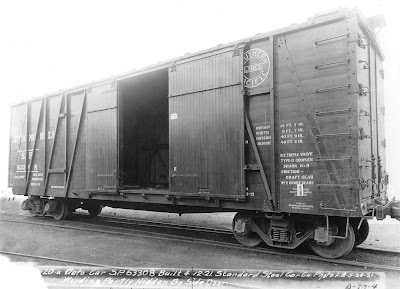The key information for this case is found in the Car Ledgers maintained by SP until about 1960 (when computer record-keeping took over). After the merger of SP into UP in 1996, Steve Peery and I were able to acquire the entire set of these Ledgers which were in use at 1960, eleven volumes in all. This set superseded an earlier set, containing information from the 1890s to about 1920, which are at the California State Railroad Museum (CSRM). Once I have completed use of these Car Ledgers for research, they too will be donated to CSRM.
The volumes in my possession appear to have been begun in 1920, likely after the return of U.S. railroads to private control after the United States Railroad Administration (USRA) had operated them during the World War I traffic emergency. The good news contained in that date is that older car data were copied into these volumes to make a complete record, instead of keeping the prior Ledgers in service; but the bad news is that a few car classes which had been entirely scrapped over the 40-year service of these Ledgers had had their Ledger pages discarded. So there are a few data missing which the date range alone would suggest would be present.
These eleven Ledger volumes were the research core for the five-volume book series I wrote, Southern Pacific Freight Cars. (If you wish, you can read more about these books, or even order them, at the Signature Press website (http://www.signaturepress.com/ ).
Now I will turn to the Class A-50-4 automobile cars. Background: in 2005, Speedwitch Media made an HO scale kit of this car, for the SPH&TS convention that year. The instruction sheet for the kit implies that this class was scrapped without applying AB brakes (they were built with K brakes), and thus would have had to be all gone by the 1953 date at which K brakes were outlawed in interchange. But in this regard, the instruction sheet is incorrect.
A fair number certainly got scrapped in the 1948–1953 time frame, but many of the cars received AB brakes before that. I can make this statement because the date of application of AB brakes is given in the Ledger for every car. I show below a pair of Ledger pages, facing pages for this car class, since all the information would not fit onto a single page. Car numbers are down the left side of each page (click to enlarge). The handwriting looks very small, because the original Ledger sheets are 14 x 17 inches, obviously considerably reduced as shown here.
Car 63140 is one of the cars which survived into 1953 (see below), and its retirement date, May 1953, is shown in the first column to the right of the column with built dates. Next is the facing page; column 18 shows AB brake application.
Car 63140 received its AB brakes in 1949, well prior to the retirement date.
Below I list some cars with retirement dates after January 1953 (these data are from the SP Car Ledger pages as just discussed). Dates in parentheses are retirement dates, i.e. removal from service; scrapping was usually within a couple of months.
First, the batch of 250 cars built for SP in 1921, numbers 63080–63328:
63084 (9-53), 63094 (3-53), 63140 (5-53), 63197 (6-53), 63297 (7-53) – all received AB brakes in 1949 or 1950, mostly at El Paso
63246 (9-53), 63261 (3-53) – received AB brakes early in 1953
63180 (6-53), 63325 (1-54) – did not receive AB brakes
Second, the 150-car batch built for T&NO in 1921 and acquired by Pacific Lines in 1936, SP 63600–63746:
63666 (4-54), AB brakes received in 1946
63699 (6-53), 63707 (5-54), AB brakes in 1949
63727 (6-53), AB brakes in 1948
This list probably isn’t exhaustive but it should provide car numbers for nearly all or all of the survivors past 1-53.
To show what we’re talking about, here is a prototype 40-foot car when it was new, photographed by SP at Los Angeles shop in 1921.
The “door and a half” design is evident, as are the end doors. The door opening as built was 10 feet, 5 inches, but in the early 1930s all these cars had their door openings widened to 12 feet, at which point they received a pair of equal-size doors. It is that modernized form of the car which Speedwitch modeled, with the interesting “steep” diagonal brace arrangement in the first panel to the right of the door.
This SP photo from Sacramento in 1933 shows a car with the wider doors and that “steep” brace.
That covers what I wanted to say about using the SP Car Ledgers. Obviously the particular case of the A-50-4 cars is only one of many instances in which these ledgers provide far more information than usually available for freight cars.
Tony Thompson




Tony, as "usual" from you... a wealth of informations for us modelers: thanks to continue to share it!
ReplyDeleteA suggestion for a future post for dumbs like me:
a good explanation and basic schematics of all different brakes (AB vs K...) from a modeler point of view will be a fine reference.
Keep the good work
Enzo Fortuna
This comment has been removed by the author.
DeleteHere are the suggestions at the core of what Arved sent: Ted Culotta in his "Essential Freight Cars" series in Railroad Model Craftsman, August and September issues for 2003, included nice sidebars on the brake gear modeling possibilities. These items are now available for download from the Steam Era Freight Cars website, at:
ReplyDeletehttp://www.steamerafreightcars.com/modeling/articles/brakesmain.html
Tony Thompson
Thanks Tony:I remember I've mentioned RMC at home! I go to refresh my memory "chips".
ReplyDelete